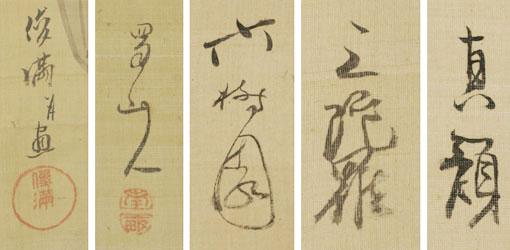Ukiyo-e
Rokkasen, the six classical poets - Fukurokuju written in one kanji - HappinessSigned: Shumman heiga
Seals: Shumman
Technique: sumi and colours on silk 93,1 x 32,2
Mounting: brown bronze damask and green silk 181,5 x 45,2
Condition: very good
Rokkasen (The six most well known Waka poets) :
Sojo Henjo,
Ariwara no Narihira,
Hun'ya no Yasuhide,
Kisen Hoshi,
Ono no Komachi,
Ootomo no Kuronushi
were the Rokkasen, the selected poets of waka in the early Heian period.
The six Waka poets derived from the anthology of poems Kokin Wakashu (905), where Ki no Tsurayuki, one of compilers, referred to them as "famous poets in the near past" in the preface. He did not give high acclaim or the title "immortals of waka" (kasen) to them, however. That title was given later. Similar Japanese poet groupings include the Thirty-six Poetry Immortals and the group of one hundred poets included in the Ogura Hyakunin Isshu.
Shumman was born in Edo. and studied with Kitao Shigemasa (1739-1820) and the poet Katori Nahiko. In the 1780s he started to design woodblock prints and at the same time studied kyoka poetry with Rokujuen. He mainly produced paintings, surimono and poetry albums.
Apart from being known as a great drinker, Nampo was an extremely important figure in the social and cultural world of Edo around 1800. He worked for the bakufu, government, but tried to become a true bunjin all his life. He was a kyôka poet, but at age 18, after the successful publication of a parodic kyôka anthology he became ‘the cultural hero’ in Edo's Ukiyo-e and literati scene.
Reference:
Araki pp. 1340-1341
Kôsan # 983
Jenkins pp. 53-56, 189-218
Rosenfield '99 B.74
Price: SOLD

